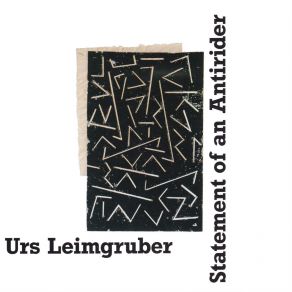Statement of an Antirider
Download links and information about Statement of an Antirider by Urs Leimgruber. This album was released in 1988 and it belongs to Jazz, Classical genres. It contains 5 tracks with total duration of 01:04:47 minutes.

|
|
|---|---|
| Artist: | Urs Leimgruber |
| Release date: | 1988 |
| Genre: | Jazz, Classical |
| Tracks: | 5 |
| Duration: | 01:04:47 |
| Buy it NOW at: | |
| Buy on iTunes $9.99 | |
Tracks
[Edit]| No. | Title | Length |
|---|---|---|
| 1. | Raga I | 21:19 |
| 2. | Leonor | 17:34 |
| 3. | Statement of an Antirider | 12:28 |
| 4. | Raga II | 9:50 |
| 5. | Sefónito | 3:36 |
Details
[Edit]The mighty-lunged Urs Leimgruber steps out from his various ensembles on this date to play completely solo with his trio of saxophones — tenor, soprano, and bass — and the flute. Like Anthony Braxton and Roscoe Mitchell nearly 20 years before him, Leimgruber is after something that does not automatically come with being a "jazz" musician: the exploration in specific environments of the world of sound as it can be encountered by his chosen instruments. European improvisers can come across as too erudite and arrogant to American fans of jazz. That's too bad, because when it comes to extending the reach of particular instruments, methodology, and what free improvisation might mean if made a dominant concern of jazz at this time in history, the Europeans have much to contribute, and a big part of that contribution is made by Leimgruber. These solos are works of revolt, resistance, and great tenderness. Leimgruber embodies Che Guevara's statement that every revolutionary is motivated by great love. His love is the love of sound. With his perfected circular breathing technique — used by other players such as John Coltrane, Rahsaan Roland Kirk, and Steve Lacy, among others — that goes back to the time of the Buddha or even before as a meditation technique, Leimgruber plays meditations (note the pieces "Raga I" & "Raga II") on the nature of vibration, timbre, and color. These 65 minutes are fascinating not only for their academic value, but for their emotional power. Leimgruber is a player who forgoes his more theoretical aspects on paper by going for the throat with his horn — even when that emotion is controlled as dictated by the texture of sound itself. And while it's true this record has nothing whatsoever to do with jazz, it has everything to do with music, and therefore every free jazz fan should take due note not only of it, but its creator.